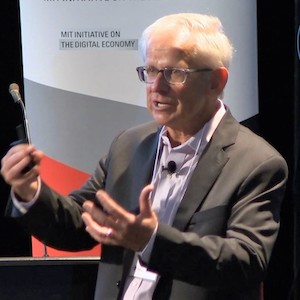 I recently participated in a nationwide (not the United States) healthcare IT planning effort and one recommendation was universal availability of patient portals. Several reviewers commented that patient portal is a loaded term - it implies that clinicians control the data and patients are given a view into it. One person said, “that’s so 10 years ago.” BIDMC has been working with patient/family shared medical records, Open Notes and various consumer-facing apps since 1999. Over that time we've discovered that patients typically do not want raw data, they want something actionable - the tools necessary to assist their navigation through the healthcare process...
I recently participated in a nationwide (not the United States) healthcare IT planning effort and one recommendation was universal availability of patient portals. Several reviewers commented that patient portal is a loaded term - it implies that clinicians control the data and patients are given a view into it. One person said, “that’s so 10 years ago.” BIDMC has been working with patient/family shared medical records, Open Notes and various consumer-facing apps since 1999. Over that time we've discovered that patients typically do not want raw data, they want something actionable - the tools necessary to assist their navigation through the healthcare process...
patient portals
See the following -
OpenNotes Introduces Advisory Board
 OpenNotes is pleased to announce that ten extraordinary advocates for health care quality and improvement are the founding members of the OpenNotes Advisory Board. OpenNotes is a national movement that urges doctors, nurses and other health care providers to share the notes they write with the patients they care for...
OpenNotes is pleased to announce that ten extraordinary advocates for health care quality and improvement are the founding members of the OpenNotes Advisory Board. OpenNotes is a national movement that urges doctors, nurses and other health care providers to share the notes they write with the patients they care for...
- Login to post comments
Patient portal 2.0
"As healthcare reform and transformation advances, providers will seek new ways to engage patients and influence behavior beyond the point of care Read More »
- Login to post comments
Patient portals business means big money
The U.S. patient portal market is booming and is expected to reach $898.4 million by 2017, up from $279.8 million in 2012 – representing a 221 percent increase, a new study says. Read More »
- Login to post comments
Patient Portals: More Than Meets The Eye
Despite many healthcare organizations employing patient portals, the portal remains an underutilized resource. This low rate of adoption may stem, at least in part, from first-generation solutions developed in years past that offer little more than a website for patients and providers to communicate... Read More »
- Login to post comments
Platform Terminology Explains Why Today's Patient Portals CAN NOT Work (Part 1)
 Patient portals have tremendous potential — but that potential has not been realized and CAN NOT be realized as portals are currently configured. An understanding of platform business models and strategy explains why today’s patient portals are inherently suboptimal. This essay is the first in an occasional series that will look at patient portals through the lenses of platform business models and strategy. Today’s post will introduce and explain platform terminology of multihoming and single homing. Future posts will look more deeply into “why” current patient portals can’t work and will propose options for portals that could work for patients.
Patient portals have tremendous potential — but that potential has not been realized and CAN NOT be realized as portals are currently configured. An understanding of platform business models and strategy explains why today’s patient portals are inherently suboptimal. This essay is the first in an occasional series that will look at patient portals through the lenses of platform business models and strategy. Today’s post will introduce and explain platform terminology of multihoming and single homing. Future posts will look more deeply into “why” current patient portals can’t work and will propose options for portals that could work for patients.
- Login to post comments
Signatures are No Longer Required for Credit Card Transactions...How Come Most Medical Records Exchanges Still Require Fax Machines?
 If you live in the U.S., you've probably had the experience of paying for a meal using a credit card. The server takes your card, disappears to somewhere in the back, does something with it that you can't see, and returns with your card, along with two paper receipts, one of which you need to sign. Everything that happens to me, I think, what is this, the 1960's?As of last week, the major credit card companies -- American Express, Discover, Mastercard, and Visa -- are no longer requiring that signature. As a Mastercard person told CNET, "It is the right time to eliminate an antiquated practice."
If you live in the U.S., you've probably had the experience of paying for a meal using a credit card. The server takes your card, disappears to somewhere in the back, does something with it that you can't see, and returns with your card, along with two paper receipts, one of which you need to sign. Everything that happens to me, I think, what is this, the 1960's?As of last week, the major credit card companies -- American Express, Discover, Mastercard, and Visa -- are no longer requiring that signature. As a Mastercard person told CNET, "It is the right time to eliminate an antiquated practice."
- Login to post comments
The Drupal API turns a CMS into a True Health Care Enterprise Application
 At the company where I work, Achieve Internet, we view Drupal as more than just a CMS — we see it as a powerful web application platform with capabilities to integrate multiple sources of information. Sporting a far-reaching and flexible API, Drupal can link together other platforms that provide APIs, such as enterprise productivity systems or electronic health records (EHRs), and essentially provide Drupal’s web pages as an interface to these systems on both a read and write basis. The growth of the platform and the community has put Drupal in a position to revolutionize the concept of a traditional CMS in one market sector after another, from the media and entertainment industries to education, travel, and government.
At the company where I work, Achieve Internet, we view Drupal as more than just a CMS — we see it as a powerful web application platform with capabilities to integrate multiple sources of information. Sporting a far-reaching and flexible API, Drupal can link together other platforms that provide APIs, such as enterprise productivity systems or electronic health records (EHRs), and essentially provide Drupal’s web pages as an interface to these systems on both a read and write basis. The growth of the platform and the community has put Drupal in a position to revolutionize the concept of a traditional CMS in one market sector after another, from the media and entertainment industries to education, travel, and government.
Read More »
- Login to post comments
The Importance Of Usability In Healthcare Technology
Patients use technology to manage and coordinate their care now more than ever before. As Meaningful Use stages 2 and 3 approach, this will only increase. Patients will be using patient portals, for example, to glean information from their records and make informed decisions regarding their health. They will view, question and validate provider remarks, thus improving accuracy, awareness and patient /provider relationships. Read More »
- Login to post comments
The Missing Ingredient in Today's Patient Portals: Network Effects (Part 4)
 As described in the first three posts in this series, today’s patient portals are inherently flawed and doomed to mediocrity. The result is that today’s patient portals cannot achieve a critical mass of adoption and utilization, and therefore portals can’t achieve network effects. In this post, we will: Summarize key points from the first three posts in this series; Explain how today’s patient portals miss out on three types of network effects; Explain the implications: why tomorrow’s portals must be reconfigured to achieve network effects
As described in the first three posts in this series, today’s patient portals are inherently flawed and doomed to mediocrity. The result is that today’s patient portals cannot achieve a critical mass of adoption and utilization, and therefore portals can’t achieve network effects. In this post, we will: Summarize key points from the first three posts in this series; Explain how today’s patient portals miss out on three types of network effects; Explain the implications: why tomorrow’s portals must be reconfigured to achieve network effects
- Login to post comments
Today's Patient Portals CAN NOT Work: Friction ACROSS Portals (Part 3)

Friction across multiple patient portals dramatically limits their usefulness—there’s no practical way for patients OR providers to reconcile and integrate information and workflow. This is the third post in our series on patient portals. We’ve used platform terminology and concepts to explain why today’s patient portals are doomed to mediocrity. Let’s recap: The first post in this series introduced the platform terminology of single-homing vs.multihoming. Patients strongly would prefer to have as few portals as possible — ideally one, i.e., a single “home”. The second post described the difference between stand-alone value and network value. Today’s patient portals can provide some stand-alone value, but they provide minimal network value. In this post we’ll discuss the pitfalls of friction across multiple portals. Your mom having seven portals is more than just inconvenient—it’s dangerous.
- Login to post comments
Top HIT Trends For 2014: Accelerated Change Is Coming
Healthcare IT News recently published a series of articles looking back at the incredible progress HIT has made over the last decade. The last nine quarters in particular, starting not surprisingly when Meaningful Use checks got posted for EMR implementation, have seen remarkable accelerated change. [...] Read More »
- Login to post comments
Trusting Healthcare Data
Healthcare is generating data at an unprecedented rate. EHR software is becoming a large repository of healthcare data. [...] We’re surrounded by healthcare data. The question is: How do we make sure they trust the data? Read More »
- Login to post comments
What is Patient and Family Engagement?
- Login to post comments
Why Some Docs Will 'Just Say No' To MU
Thousands of eligible providers are working diligently toward EHR incentive payments, but some practices are choosing a different route: abandoning meaningful use altogether in favor of their own solutions, and finding ways to make up for the penalties they’ll incur down the road...
- Login to post comments
Why Your Organization Can’t Afford To Skimp On Interoperability Anymore
Interoperability is a key enabler for providers and payers to deliver on the promise of health care reform. Despite increased adoption of electronic medical records (EMRs), only a fraction of providers can demonstrate the routine ability to exchange data efficiently, prompting public criticism of the application software vendors as a barrier to achieving interoperability objectives. Recognizing that interoperability is essential, the Office of the National Coordinator released an interoperability road map intended to drive the market toward a common data set for easier data exchange.
- Login to post comments